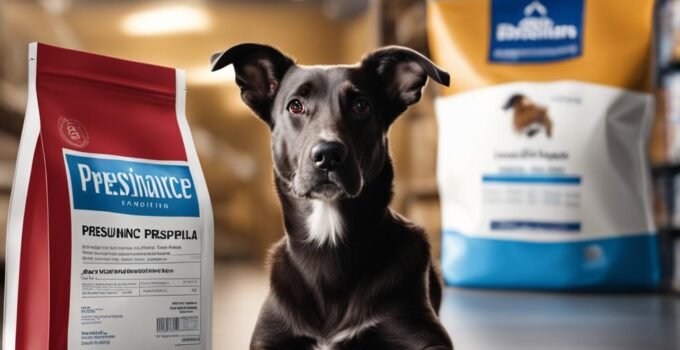Prescription pet food is any food that requires a prescription from a veterinarian. It is formulated to address specific health conditions in pets such as arthritis, bladder stones, cancer, diabetes, and more. Prescription food can help manage or treat these conditions by meeting the unique nutritional needs of pets. However, prescription food is generally more expensive than regular pet food and should only be used under a veterinarian’s guidance. It is important to note that not all pet insurance providers cover prescription food, so it is necessary to check the specifics of individual policies regarding prescription coverage.
Key Takeaways:
- Prescription pet food requires a prescription from a veterinarian and is formulated to address specific health conditions in pets.
- Prescription food is more expensive than regular pet food and should be used under a veterinarian’s guidance.
- Not all pet insurance providers cover prescription food, so it is important to check individual policy details.
Now let’s explore why prescription pet food is needed and the types of pets that can benefit from it.
Why Is Prescription Pet Food Needed?
Prescription pet food is an essential component in the treatment and management of various acute and chronic conditions in pets. It serves a vital role in providing targeted nutrition to address specific health needs and alleviate symptoms. Prescription pet food is carefully formulated to meet the unique dietary requirements of pets with conditions such as arthritis, bladder stones, cancer, dental problems, diabetes, food allergies or sensitivities, gastrointestinal issues, heart disease, joint problems, kidney disease, liver disease, and weight management.
Prescription pet food not only helps to alleviate the symptoms associated with these conditions but also aids in post-surgical recovery. By offering balanced nutrition, it supports the overall well-being of pets and enhances their quality of life. Additionally, prescription pet food can assist in managing nutrient deficiencies that may arise from certain medical conditions.
It is crucial to follow the guidance of a veterinarian when using prescription pet food. Veterinarians play a critical role in diagnosing and assessing the specific needs of pets, and they prescribe appropriate prescription diets to address those needs effectively. By following their recommendations, pet owners can ensure that pets receive the necessary nutrients and treatment for their health conditions.
| Health Condition | Prescription Food Purpose |
|---|---|
| Arthritis | Support joint health and reduce inflammation |
| Bladder Stones | Dissolve or prevent the formation of urinary stones |
| Cancer | Provide essential nutrients and support the immune system |
| Dental Problems | Help maintain oral health and aid in chewing difficulties |
| Diabetes | Regulate blood sugar levels and promote weight management |
| Food Allergies or Sensitivities | Eliminate allergenic ingredients and support digestive health |
| Gastrointestinal Problems | Provide easy-to-digest nutrition and promote healthy digestion |
| Heart Disease | Control sodium levels and support cardiovascular health |
| Joint Problems | Support joint mobility and reduce discomfort |
| Kidney Disease | Manage protein and phosphorus intake to support kidney function |
| Liver Disease | Regulate nutrient intake and support liver function |
| Weight Management | Control calorie intake and promote healthy weight loss or gain |
What Types of Pets Have Prescription Food?
Prescription food is primarily available for cats and dogs, as they are the most popular pets in the United States. Large pet food companies typically manufacture prescription food for these two animals. However, there may be specialty or premium foods available for other pets such as birds, rodents, snakes, and more. It is important to note that prescription options for these pets may be limited compared to those available for cats and dogs.
Comparison of Prescription Food Availability for Different Pets
| Pet Type | Availability of Prescription Food |
|---|---|
| Cats | Available |
| Dogs | Available |
| Birds | Limited availability |
| Rodents | Limited availability |
| Snakes | Limited availability |
What Is The Average Cost of Prescription Pet Food?
The cost of prescription pet food can vary based on the type of food and the pet’s consumption. Retail pricing on popular pet food retailers’ websites shows that prices for prescription dog and cat food range from $4 to $7 per pound. For example, prescription dog food for a 30-pound dog can cost anywhere from $781.10 to $1,222.75 per year. It is important to note that prescription pet food is generally more expensive than regular, over-the-counter pet food.
Prescription pet food is specially formulated to meet the specific nutritional needs of pets with certain health conditions. The higher cost reflects the unique ingredients and careful formulation required to address these conditions effectively. While the price may seem higher, the benefits of prescription pet food can significantly contribute to the overall well-being and health of your pet.
Is Prescription Food Covered By Pet Insurance?
When it comes to prescription food for pets, one of the common questions pet owners have is whether pet insurance covers the cost. The answer is that it depends on the insurance provider and the specific policy. Some pet insurance companies do offer coverage for prescription food, but the details may vary.
For example, popular providers like ASPCA, Nationwide, and Spot offer coverage for prescription food as part of their standard plans. However, providers like Figo and Healthy Paws do not include prescription food coverage. It’s essential for pet owners to review the details of their policy or consult with the insurance provider to determine if prescription food is covered and to what extent.
The coverage for prescription food can differ in terms of the percentage of reimbursement and the conditions under which it is covered. Some insurance companies may provide full or partial reimbursement for prescription food, while others may have limitations or specific conditions for coverage. It’s crucial to carefully review the policy details to understand the coverage for prescription food.
Here is a comparison of a few pet insurance providers and their coverage for prescription food:
| Insurance Provider | Prescription Food Coverage |
|---|---|
| ASPCA | Covered in standard plans |
| Nationwide | Covered in standard plans |
| Spot | Covered in standard plans |
| Figo | Not covered |
| Healthy Paws | Not covered |
It’s important for pet owners to explore different insurance providers and policies to find the one that offers the desired coverage for prescription food. This can help offset the costs of prescription diets and make them more affordable for pet owners.
Many pet insurance providers offer different levels of coverage and options for add-ons, allowing pet owners to tailor their policies to their pets’ specific needs. Comparing different providers and reviewing the details of their coverage for prescription diets, including reimbursement amounts and limitations, can help pet owners make informed decisions about pet insurance plans.
Comparison of Pet Insurance Providers’ Prescription Food Coverage
Different pet insurance providers offer varying coverage for prescription food. Some providers, such as ASPCA and Nationwide, include coverage for prescription food in their standard plans, while others, like Embrace and Trupanion, offer it as an add-on option. When considering pet insurance, it is crucial to review the specifics of each provider’s coverage to determine if prescription food is included and to what extent.
Here are some factors to consider when comparing the coverage for prescription food:
- Reimbursement percentage: Some insurance providers may offer higher reimbursement percentages for prescription food compared to others. It is important to understand how much of the cost will be reimbursed.
- Limitations or conditions for coverage: Some policies may have specific limitations or conditions for covering prescription food, such as requiring a diagnosis from a veterinarian or limiting the number of covered prescription meals.
- Additional fees: Certain insurance providers may charge additional fees for covering prescription food. It is essential to check if there are any extra costs associated with prescription food coverage.
Reviewing the coverage details and comparing policies from different pet insurance providers will help you make an informed decision about which plan offers the best coverage for prescription food.
| Insurance Provider | Prescription Food Coverage | Reimbursement Percentage | Limitations/Conditions | Additional Fees |
|---|---|---|---|---|
| ASPCA | Included in standard plans | Up to 80% reimbursement | Requires diagnosis from a veterinarian | No additional fees |
| Nationwide | Included in standard plans | Up to 90% reimbursement | No limitations/conditions | No additional fees |
| Embrace | Add-on option | Up to 80% reimbursement | Requires prior authorization | Additional fee applies |
| Trupanion | Add-on option | Up to 90% reimbursement | No limitations/conditions | No additional fees |
Conclusion
In conclusion, the coverage for prescription pet food varies among pet insurance providers. It is important to review the policy details and consult with insurance providers to determine if pet insurance covers prescription diets and to what extent. Prescription food plays a crucial role in managing and treating certain health conditions in pets, offering specialized nutritional support. While prescription food may be more expensive than regular pet food, some pet insurance providers offer coverage for prescription diets, providing financial assistance to pet owners.
When considering pet insurance options, it is essential to carefully evaluate the specific needs of your pet and the coverage options available. Look for insurance plans that specifically mention pet insurance for prescription dog food or pet insurance for prescription medications. Coverage may vary in terms of reimbursement percentage, limitations or conditions for coverage, and any additional fees associated with prescription food coverage. By making informed decisions about pet insurance and prescription food, you can help ensure that your pet receives the necessary care without financial strain.
Remember, prescription food should be used under the guidance of a veterinarian, as they can determine the appropriate diet for your pet’s specific health condition. While not all pet insurance providers cover prescription diets, those that do can alleviate some of the financial burden associated with managing your pet’s health. By exploring the coverage options provided by different insurers and consulting with your veterinarian, you can make the best decision for your pet’s wellbeing and your own peace of mind.



